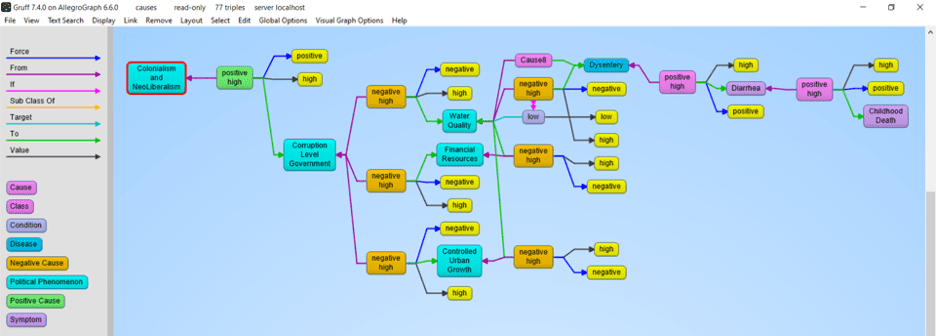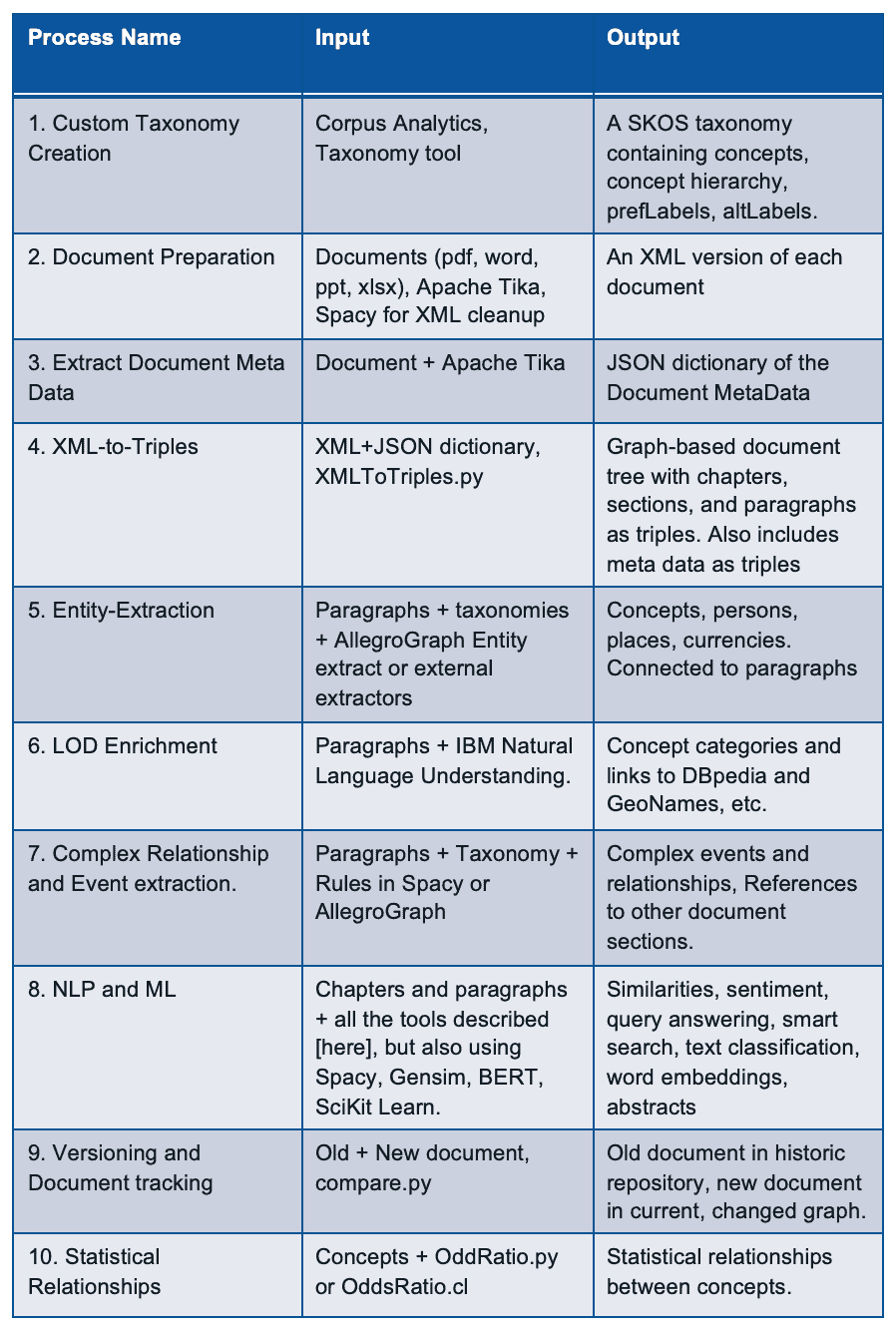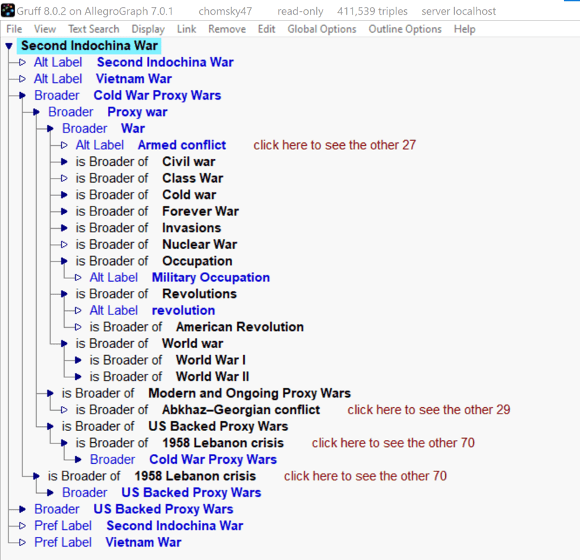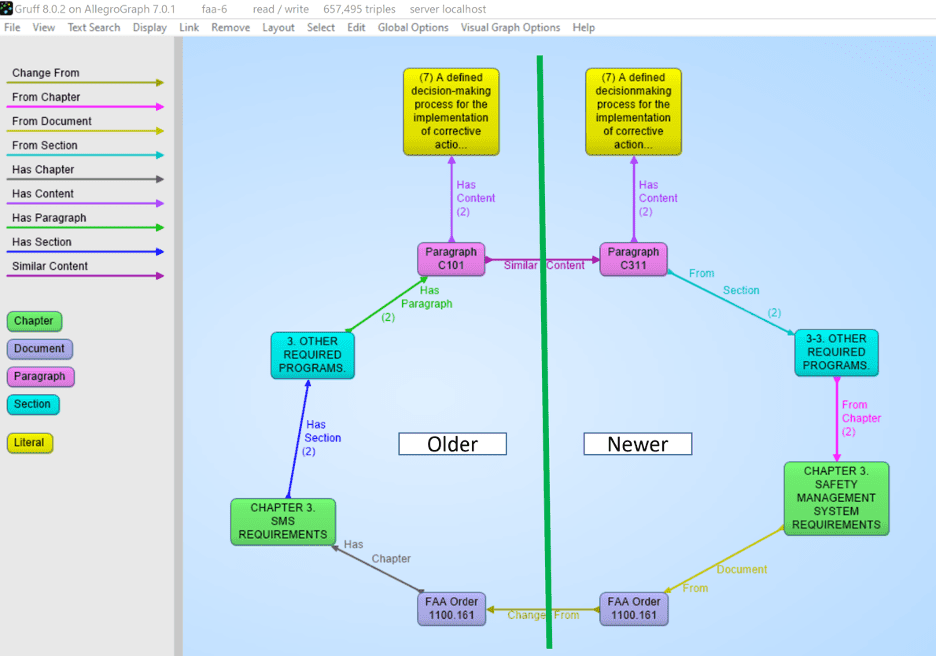
- 24 April, 2020
Document Knowledge Graphs with NLP and ML
A core competency for Franz Inc is turning text and documents into Knowledge Graphs (KG) using Natural Language Processing (NLP) and Machine Learning (ML) techniques in combination with AllegroGraph. In this document we discuss how the techniques described in [NLP and ML components of AllegroGraph] can be combined with popular software tools to create a robust Document Knowledge Graph pipeline.
We have applied these techniques for several Knowledge Graphs but in this document we will primarily focus on three completely different examples that we summarize below. First is the Chomsky Legacy Project where we have a large set of very dense documents and very different knowledge sources, Second is a knowledge graph for an intelligent call center where we have to deal with high volume dynamic data and real-time decision support and finally, a large government organization where it is very important that people can do a semantic search against documents and policies that steadily change over time and where it is important that you can see the history of documents and policies.
Example [1] Chomsky Knowledge Graph
The Chomsky Legacy Project is a project run by a group of admirers of Noam Chomsky with the primary goal to preserve all his written work, including all his books, papers and interviews but also everything written about him. Ultimately students, researchers, journalists, lobbyists, people from the AI community, and linguists can all use this knowledge graph for their particular goals and questions.
The biggest challenges for this project are finding causal relationships in his work using event and relationship extraction. A simple example we extracted from an author quoting Chomsky is that neoliberalism ultimately causes childhood death.

Example 2: N3 Results and the Intelligent Call Center
This is a completely different use case (See a recent KMWorld Articlehttps://allegrograph.com/knowledge-graphs-enhance-customer-experience-through-speed-and-accuracy/). Whereas the previous use case was very static, this one is highly dynamic. We analyze in real-time the text chats and spoken conversations between call center agents and customers. Our knowledge graph software provides real-time decision support to make the call center agents more efficient. N3 Results helps big tech companies to sell their high tech solutions, mostly cloud-based products and services but also helps their clients sell many other technologies and services.
The main challenge we tackle is to really deeply understand what the customer and agent are talking about. None of this can be solved by only simple entity extraction but requires elaborate rule-based and machine learning techniques. Just to give a few examples. We want to know if the agent talked about their most important talking points: that is, did the agent ask if the customer has a budget, or the authority to make a decision or a timeline about when they need the new technology or whether they actually have expressed their need. But also whether the agent reached the right person, and whether the agent talked about the follow-up. In addition, if the customer talks about competing technology we need to recognize that and provide the agent in real-time with a battle card specific to the competing technology. And in order to be able to do the latter, we also analyzed the complicated marketing materials of the clients of N3.
Example 3: Complex Government Documents
Imagine a regulatory body with tens of thousands of documents. Where nearly every paragraph has reference to other paragraphs in the same document or other documents and the documents change over time. The goal here is to provide the end-users in the government with the right document given their current task at hand. The second goal is to keep track of all the changes in the documents (and the relationship between documents) over time.
The Document to Knowledge Graph Pipeline

Let us first give a quick summary in words of how we turn documents into a Knowledge Graph.
[1] Taxonomy Creation
Taxonomy of all the concepts important to the business using open source or commercial taxonomy builders. An available industry taxonomy is a good starting point for additional customizations.
[2] Document Preparation
We then take a document and turn it into an intermediate XML using Apache Tika. Apache Tika supports more than 1000 document types and although Apache Tika is a fantastic tool, the output is still usually not clean enough to create a graph from, so we use Spacy rules to clean up the XML to make it as uniform as possible.
[3] Extract Document MetaData
Most documents also contain document metadata (author, date, version, title, etc) and Apache Tika will also deliver the metadata for a document as a JSON object.
[4] XML to Triples
Our tools ingest the XML and metadata and transform that into a graph-based document tree. The document is the root and from that, it branches out into chapters, optionally sections, all the way down to paragraphs. The ultimate text content is in the paragraphs. In the following example we took the XML version of Noam Chomsky’s book Media Control and turned that into a tree. The following shows a tiny part of that tree. We start with the Media Control node, then we show three (of the 11) chapters, for one chapter we show three (of the 6) paragraphs, and then we show the actual text in that paragraph. We sometimes can go even deeper to the level of sentences and tokens but for most projects that is overkill.

[5] Entity Extractor
AllegroGraph’s entity extractor takes as input the text of each paragraph in the document tree and one or more of the taxonomies and returns recognized SKOS concepts based on prefLabels and altLabels. AllegroGraph’s entity extractor is state of the art and especially powerful when it comes to complex terms like product names. We find that in our call center a technical product name can sometimes have up to six synonyms or very specific jargon. For example the Cisco product Catalyst 9000 will also be abbreviated as the cat 9k. Instead of developing altLabels for every possible permutation that human beings *will* use, we have specialized heuristics to optimize the yield from the entity extractor. The following picture shows 4 (of the 14) concepts discovered in paragraph 16. Plus one person that was extracted by IBM’s NLU.


[6] Linked Data Enrichment
In many use cases, AllegroGraph can link extracted entities to concepts in the linked data cloud. The most prominent being DBpedia, wikidata, the census database, GeoNames, but also many Linked Open Data repositories. One tool that is very useful for this is IBM’s Natural Language Understanding program but there are others available. In the following image we see that the Nelson Mandela entity (Red) is linked to the dbpedia entity for Nelson Mandela and that then links to the DBpedia itself. We extracted some of his spouses and a child with their pictures.

[7] Complex Relationship and Event Extraction
Entity extraction is a first good step to ‘see’ what is in your documents but it is just the first step. For example: how do you find in a text whether company C1 merged with company C2. There are many different ways to express the fact that a company fired a CEO. For example: Uber got rid of Kalanick, Uber and Kalanick parted ways, the board of Uber kicked out the CEO, etc. We need to write explicit symbolic rules for this or we need a lot of training data to feed a machine learning algorithm.
[8] NLP and Machine Learning
There are many many AI algorithms that can be applied in Document Knowledge Graphs. We provide best practices for topics like:
[a] Sentiment Analysis, using good/bad word lists or training data.
[b] Paragraph or Chapter similarity using statistical techniques like Gensim similarity or symbolic techniques where we just the overlap of recognized entities as a function of the size of a text.
[c] Query answering using word2vec or more advanced techniques like BERT
[d] Semantic search using the hierarchy in SKOS taxonomies.
[e] Summarization techniques for Abstractive or Extractive abstracts using Gensim or Spacy.
[9] Versioning and Document tracking
Several of our customers with Document Knowledge Graphs have noted the one constant in all of these KGs is that documents change over time. As part of our solution, we have created best practices where we deal with these changes. A crucial first step is to put each document in its own graph (i.e. the fourth element of every triple in the document tree is the document id itself). When we get a new version of a document the document ID changes but the new document will point back to the old version. We then compute which paragraphs stayed the same within a certain margin (there are always changes in whitespace) and we materialize what paragraphs disappeared in the new version and what new paragraphs appeared compared to the previous version. Part of the best practice is to put the old version of a document in a historical database that at all times can be federated with the ‘current’ set of documents.
Note that in the following picture we see the progression of a document. On the right hand side we have a newer version of a document 1100.161 with a chapter -> section -> paragraph -> contents where the content is almost the same as the one in the older version. But note that the newer one spells ‘decision making’ as one word whereas the older version said ‘decision-making’. Note that also the chapter titles and the section titles are almost the same but not entirely. Also, note that the new version has a back-pointer (changed-from) to the older version.

[10] Statistical Relationships
One important analytic one can do on documents is to look at the co-occurrence of terms. Although, given that certain words might occur more frequently in text, we have to correct the co-occurrence between words for the frequency of the two terms in a co-occurrence to get a better idea of the ‘surprisingness’ of a co-occurrence. The platform offers several techniques in Python and Lisp to compute these co-occurrences. Note that in the following picture we computed the odds ratios between recognized entities and so we see in the following gruff picture that if Noam Chomsky talks about South Africa then the chances are very high he will also talk about Nelson Mandela.








